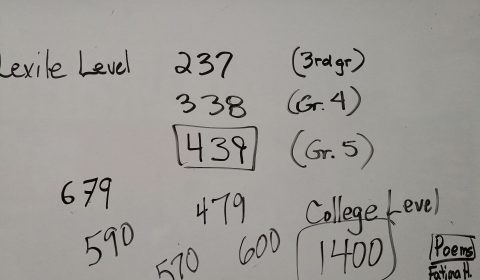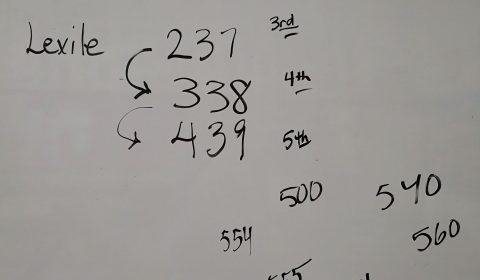I am currently reading The 4 Disciplines of Execution by Chris Chesney, Sean Covey, and Jim Huling. It is a business book, but we are using it to improve teacher effectiveness at our school this year.
Last spring our innovative principal told me about the book and how it would inform our goal for the new school year. He recommended it, so I bought the book. It has been a slow read because it’s not what I’m usually interested in, but I’m plowing through and always asking how we can use the concepts in our school. Our WIG, or wildly important goal, is to raise our ELEOT scores in two categories from 2.8 to 3.2 by June 2018. Clearly a measurable goal from x to y by when goal. Meeting this goal will mean that children will be given a more equitable and high expectations learning environment than they had last year. If we succeed, students will be more engaged in learning, with more opportunities for differentiation and higher order thinking.
In our department, Grade 3-5 English Subjects, we created a lead measure to go with that WIG. Our lead measure is:
“Successfully implement at least two collaborative / student-centered highly engaging learning strategies each week from the list below.”
- Inside-Outside Circles
- Think Team Share / Rally Robin
- Think Pair Share
- A/B Pyramid Game
- Four Corners
- Numbered Heads Together
We are just beginning this week to hold weekly WIG sessions, where we will develop a cadence of accountability as we focus on making our lessons more student-centered and collaborative.
As I continued to read the book and plan for our department “game,” I began thinking why can’t we do something like this with the children? I began to dream about how 4DX can translate into the classroom. I could include them in developing reading goals for individuals as well as for the whole grade 5 English group.
It’s easy for teachers to ask students to read at home for homework, but it has not been something that is easy to monitor. I’m opposed to elaborate reading journals, which tend to limit reading for joy and make the reading log or book reports and projects the emphasis.
I engaged the children to help me make the homework plan and the goals that would improve our reading.
It is early in the process, but this is what we have so far.
Students helped create the WIG, our wildly important goal:
“We will raise Grade 5’s mean Lexile Level as measured by the MAP test from 338 to 500 by June 2018.”

We negotiated the 500 by looking at the amount they grew from two years back. In grade 3, the average was 237, and in grade 4, 338. In grade 5, we might expect 439, but they rightly wanted to push themselves. I had to explain that there was no such thing as a million or even 6000 Lexile score. I helped them get into the ball park, and I said 1400 was approaching college level, so then they began given realistic and achievable goals: 550, 600, 490, etc. (NOTE about those low Lexile scores: My students are learning English as a second language–most of their early years are spent studying Arabic. Only 25% of their day is in English from Pre-K to grade 3. In grades 4-5, it goes up to 50% of their day in English and 50% in Arabic subjects.)
I took all the figures they predicted from both classes and averaged them. I then took that number and averaged it with the 439 expected growth. It came out to 497, which I rounded to 500. I’m not sure how scientific that plan was, but it seemed like a realistic, yet challenging goal.
This is definitely a lag measure. We will only see results three times a year–In September, February and June. We are now in the process of taking their baseline MAP test, which will measure their Lexile Level. That will be recorded on the WIG scoreboard for September, comparing it to last spring’s results.
Meanwhile, we have created lead measures.
1. We will read in an English book we enjoy and plan to finish for 20 or more minutes a day at home 4 times a week.
Each day when we come to English class, we self-report on this lead measure, including me. We have only done it three days, and already there are success stories. I saw more than one face light up the second day, and heard children say, “I did it. I read at home yesterday!” They were proud to move their magnet to YES.
We also had a talk about honesty, and how the reporting is going to help us reach our goal of improving our reading. If you have to keep saying NO until you can figure out how to get it done, it’s OK. It’s a safe place to be honest.
I loved how in each class, on the first day, the first brave souls to put their NO in place were strong students and good readers who had been busy with other things and had to say NO. I praised them for their honesty and leadership. Then I watched the other “NOs” fill in behind them. They quickly learned it was a safe space for honest reporting, no shame here.
In fact, the first day I had to say NO myself. That evening at bedtime, I realized I had not read again! I would have to say no a second day in a row. I didn’t want to have to say NO, so I stayed up. My husband went to bed. I took my Kindle and paced the length of my house while I read–this kept me awake and helped me break 10,000 steps for the day, as well. (I was reading the 4DX book.) The next day when I told the class what happened, I was able to tell from experience that they, my students, had inspired me to read. I didn’t want to come back to school and have to say NO again.
It’s not only that I want to win the Reading Game and get lots of YESes on the board, but I also want to reach my 40-book goal this year. I realized if I don’t finish this book and start another book, I will never be able to read 40 books. How can I read all those books if I don’t read at least 20 minutes a day?
Here’s our Reading Game scoreboard for after the long weekend. This weekend my goal is to finish The 4 Disciplines of Execution, and thanks to our game I will succeed.
Our other lead measures:
2. Bring the book I’m currently reading every Sunday to school for our WIG sessions.
3. Record the titles of books read on our reading log to show progress on our own personal goal.
Well, that’s all we have so far. It’s a new process for all of us. We still have to figure out how to make a scoreboard that will show if we are winning on our lead measures or not. I’m having the students help with that.
The question will come if we are disciplined in carrying out the fourth discipline–developing a cadence of accountability. I know from experience how easy it is to become undisciplined. I like this quote from the book:
Even though the 4 Disciplines are easy to understand, in the end, they are still disciplines. It takes real work to make them an established part of organization’s operation and culture. (page 252)

